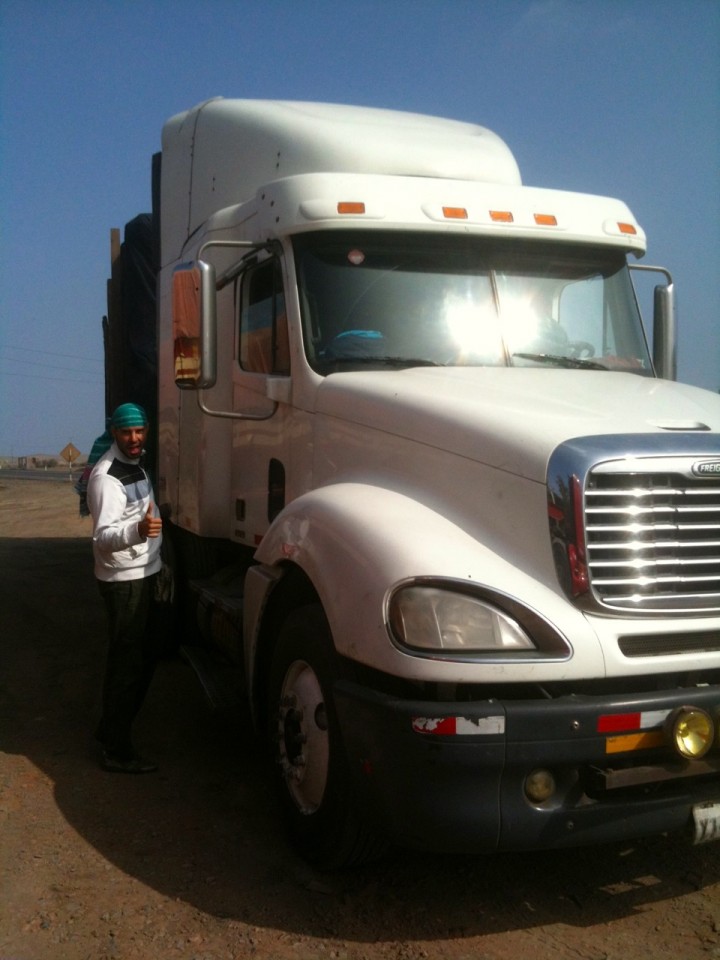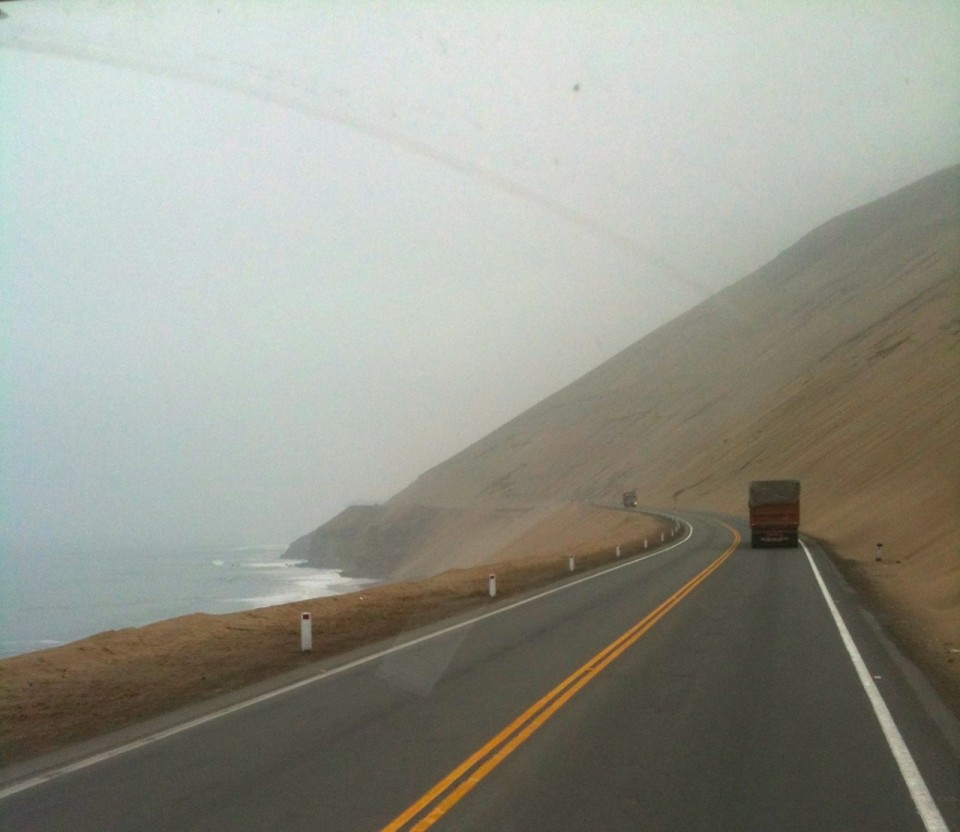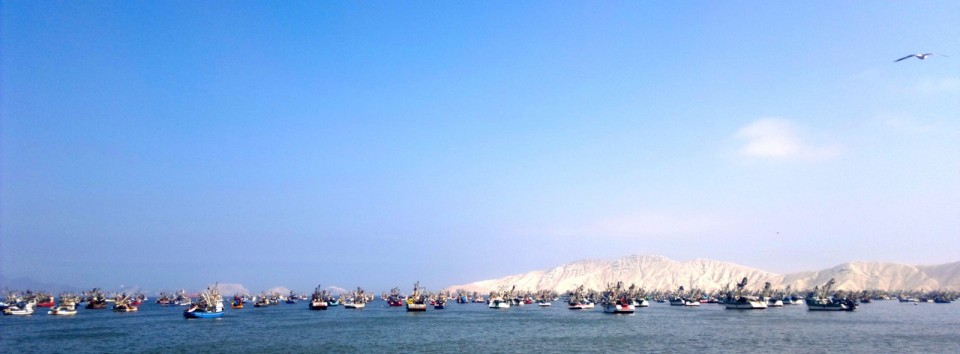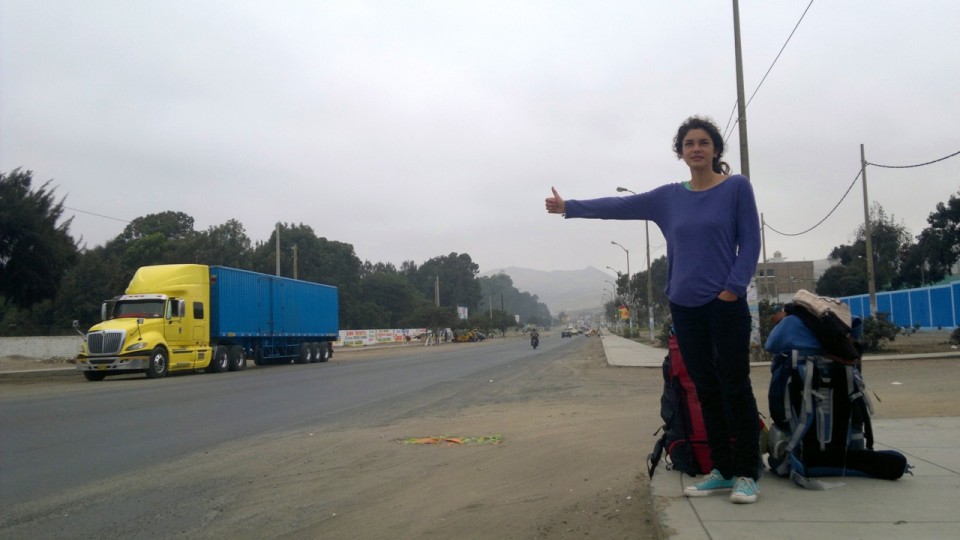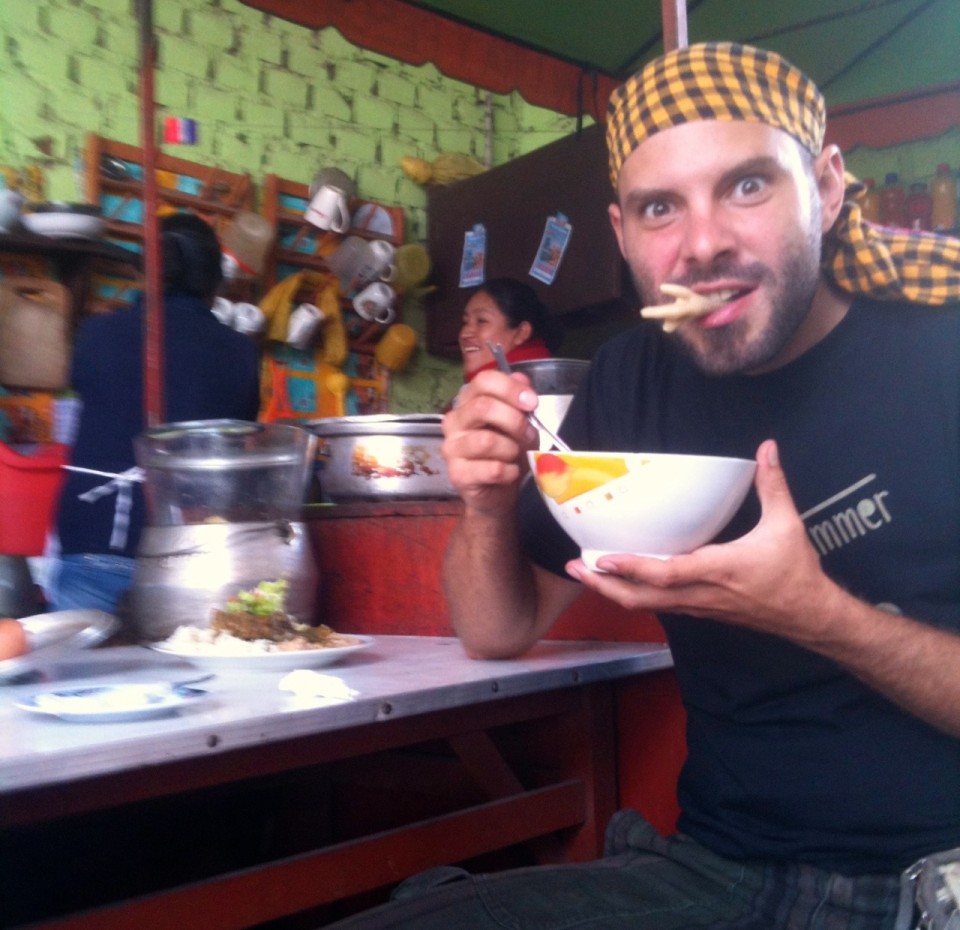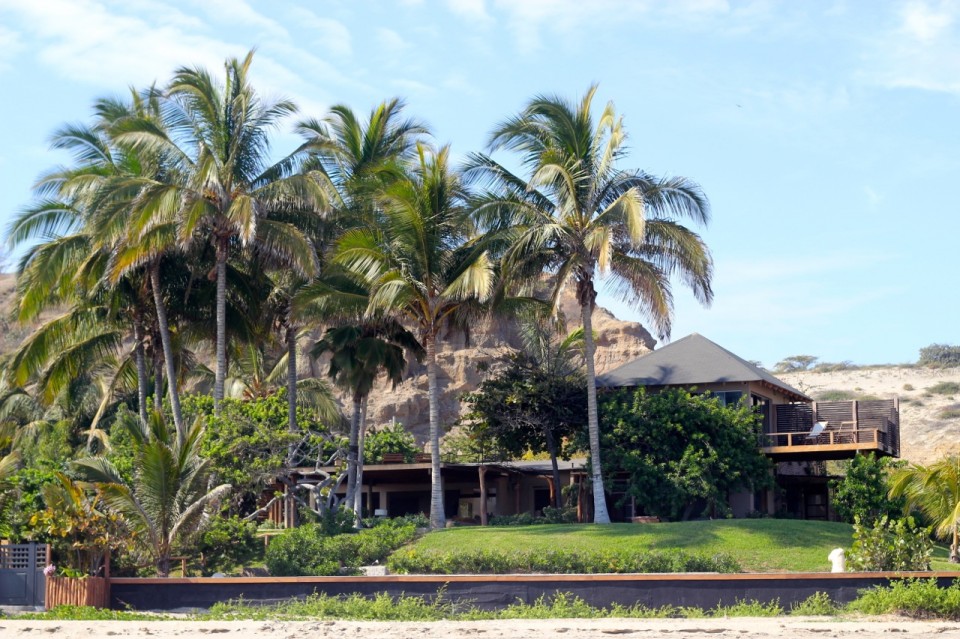After the whole misfortune with having our backpacks stolen in Lima we didn’t think twice – the very same morning when we got up we took the local bus to the suburbs of the capital of Lima looking for a good place to hitchhike towards north. Our first try of hitchhiking in South America!
On each continent, just like in every country I’ve been to, people try to talk you out of doing it since that kind of travelling is dangerous, only because they heard of a negative experience. They care about you. The same thing did a lady who was selling coffee on a street and with whom we talked before hitchhiking: Es muy peligroso! Of course, all things should be taken into consideration, see both positive and negative aspects (so, basically, you should simply use the common sense) and then make the decision. Just like with all the things in one’s life.
Since in our head the probability that a truck driver who, in his free time or during his work time, is a serial killer of hitchhikers will pick you up is pretty much the same as the one in which a bus driver will drive you off a cliff, we chose a cheaper and, in fact, more practical solution. Very often hitchhiking is a much faster and more comfortable way of travelling, especially when you find yourself in a country where the public transportation is slow and uncomfortable; in that way after only two minutes of waiting a truck pulled over – it was going straight to our next destination, Chimbote.
We exchanged a few smiles with the driver and soon we were driving along the Panamericana – the longest road in the world that runs from Alaska all the way to the south of Argentina – 50.000 kilometers with only one break in the road – a gap 156 kilometers long from the Central to South America. We were marveled by the sights around us: on the right side we were surrounded by huge sandy dunes that could stand side to side to those in Sahara desert, while on the left side the road was facing a huge cliff that led to the wavy Pacific ocean. The driver was calm, cheerful and with just the right amount of willingness to talk – he seemed like a person you can trust. He was just what we needed while riding between two fires, especially when we passed by a truck that was turned over, with a half of its load somewhere on the cliff.
However, the cliffs were soon behind us, so we could breathe easily, relax and enjoy looking at the desert environment. I had no idea that I’d find a desert in Peru. I had no idea that Lima was the second biggest city in the world, after Cairo, that was built in the middle of a desert.
Also, with the driver who didn’t know a single word in English we had free lessons of Spanish – another positive aspect of hitchhiking! Mare spoke Spanish way better than me, but, after all, she did have eight months of wandering around this part of the world behind her, so I mostly listened to her and absorbed everything. Learning Spanish was one of the main reasons for my coming to South America, even though, now that I think of it, it could be more difficult than expected: I didn’t count on having a girl around with whom I would be able to speak in Croatian, and, in that way, not be forced to use exclusively the local language.
Half way to our destination we made a stop in Peruvian restaurant to try ceviche – a local specialty and the pride of the entire nation: it’s made of fresh fish filet, marinated in lime juice and it’s served with onions, corn, sweet potato and all kinds of things, depending on the restaurant you find yourself in. Our remark: extraordinary, but very delicious!
With the first signs of night we arrived to Chimbote and met James and Gigi, our hosts and the main reason why we came to that town 400 kilometers distant from Lima and not that much famous.
That was where we tried out the famous recipe of choosing the destination we’d be visiting: since there were 1200 kilometers from Lima to Mancora (a place in the north of Peru where we’d be volunteering for a few weeks) we split the trip in three parts (even though it depends on the country, usually by hitchhiking I pass between 200 and 500 kilometers a day), saw which cities were on our way, found some interesting people on CouchSurfing, sent them a few e-mails, some of them agreed on hosting us and that was it. All it takes is a bit of planning, a bit of internetting, but also a small dose of relaxation – you never know what can change in the very same instant…
James and Gigi were waiting for us in front of their apartment, where they were about to begin with their work – a few weeks before they’d started making tacos on the street and since James was American they called it Tacos El Gringo. Soon the word was spread around the town and they already had a well organized job. When I tried that Mexican specialty I knew the exact reason of their success. In his free time James was doing some joggling so when he was bored or needed some money he would take anything he could grab, go to the first crossroads and when the lights were red he would make a living.
The town itself wasn’t that sensational: it is one of the biggest fishing ports in the country, the central market was colorful and full of life and the center of everything was the main square, Plaza de Armas, which is, in fact, the name of every bigger square in almost all cities of Peru. In the evening we had our bench; with a smile on our face we would say no to the street vendors of sweets, talked to the Girl with the Saddest Tattoo, a friend of our hosts, and had an interesting encounter with a young man in a suit and tie who came to preach about the religion.
And so, two days after we arrived there, after hanging out with our hosts and after taking a few walks around the town, we decided to move on. Also, we decided to stick to our way of travelling – we took an overcrowded van, the most common way of transportation (it’s interesting when you think how Asia, Africa and now South America have so many things in common, at least those related to the transportation), got to the north exit of the town and stuck out our thumbs.
Although the Peruvians have their own expression for hitchhiking – tirar dedo (stick out the thumb) I can’t say that all of them understood what you’re doing by the road with your thumb stuck out. So, once again, just like in African and Asian countries, you had to spend quite some time in explaining all kinds of taxi, van and car drivers what you were doing and how you want to get to the next city. However, with some patience and with being careful to find the right moment to stick out your thumb, you did find what you were looking for at the moment: a ride in a truck to the next big city – 130 kilometers distant Trujillo. It was exactly half way to the planned destination for that day – Chiclayo.
After another lesson in Spanish the driver left at the entrance of the city because at that point the road split in two: the one part was leading to the center, while the other one was leading to the detour and further to the north. Not long after, a local man pulled over in his hippy VW inviting us to hop on in. He drove along the detour, but soon he made a turn to the city. We told him to leave us on the detour, but quite convinced he told us not to worry adding that he knew of an excellent place where we could carry on with our hitchhiking. Ten minutes later he left us in the center of the city. The road to hell is paved with good intentions. Or the road to the center of the city. Whatever.
One of the important lessons in hitchhiking: do not end up in the center of a city. From there you have to take some kind of transportation to the suburbs so you could proceed with your plan. Still, if you don’t feel like it, if the night is getting closer, or if the transportation is cheap, sometimes you opt for an easier way: you buy a bus ticket for the remaining 200 and something kilometers. That was exactly what we did.
While we were waiting for our bus to depart, we visited a nearby street stand where some ladies were preparing and selling food: I had a large meal consisting of a bowl of soup, salad and a main course; it cost me only 5 soles (approx. 2$). Mare only had a salad which they didn’t charge us. And which tasted a bit funny.
And there you go, another travel lesson, especially in underdeveloped countries: even though the food they sell on the streets is the cheapest, the most local and the most practical way of eating, at the same time, it is the most dangerous one. There is a great chance of food poisoning. However, I/we think that it is a good thing to get your body accustomed to the local bacteria, especially if you plan to stick around in that part of the world for a bit. If you’re staying only for a short period of time you probably can’t afford stomach ache and the inevitable adventure of going from the bedroom to the bathroom every twenty minutes. We had plenty of time.
We spent the night sick in a cheap hotel room in Chiclayo; we didn’t manage to see much of the city since the following day, still feeling a bit exhausted we were off to Mancora.
What followed were the bus adventures. The first step was handing over the passport while we were buying the ticket. Each ticket had a name on it. The next step was getting out of the waiting room, when you had to show the passport once again and leave your fingerprint. The third step was the very entering in the bus and passing through the security who frisked you with that airport metal detector. The last step, once you’re seated and smiled politely at the exaggerated controls, is a man who with his small camera records the face of the each passenger.
The ride in the bus is, in fact, much more interesting than I’d thought during the past few years of hitchhiking around the world. Even if I didn’t count all the procedure of control before we actually started driving. You were at peace. You didn’t have to share your life story with anyone or listen to some else’s. You could read a book. You could write. You could listen to music. You could learn Spanish. You could watch a synchronized Hollywood movie. You could play ukulele. You could smile and say something to a 5-year-old girl that was sitting in front of you. And she could respond in the same way. Also, she could, while getting off the bus, come to you accompanied by her mother and give you a small red bag with a few toys in it and wave good bye to you.
The magic happens even in the buses!
And after a few hours in the bus the magic was waiting for us in Mancora: in the shape of the slimmest moon and a starry sky. We’d never see such sight, not even in Peru, given all the fog and lights of the cities we’d been in. There was no such thing in Mancora: a small village in the north of the country, with a couple of thousands of inhabitants and where it was always summer.
From the centre of Mancora we took a mototaxi (also known by the name of rickshaw or tuk-tuk: another similarity with Asia and Africa) to Las Positas, a small place some 5 kilometres towards south, the home of KiChich, a hotel that still wasn’t open where we would be volunteering for the following few weeks. We didn’t know much about it, expect that it was situated on the beach; that it had six rooms; that its cuisine was based on vegetarian/raw food and, above all, we knew what it looked like.
Cristina, the owner of the hotel, was waiting for us on a dusty street, behind a wooden bridge. She hugged us, and really sincerely thanked us for coming there, and for the help we would be giving her during the following few weeks about getting the last things done with the opening of the hotel which was her long life dream.
We hugged her back and thanked her for her welcome after which we ate a delicious dinner she served, went to a night tour of the hotel, settled in the house for the volunteers, gave another look at the stunning sky on the terrace, made a few wishes since there were some falling stars and felling quite happy went to sleep.
